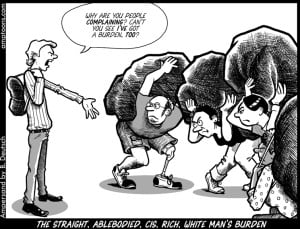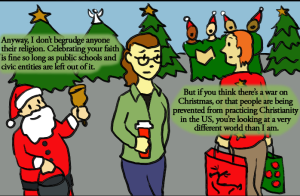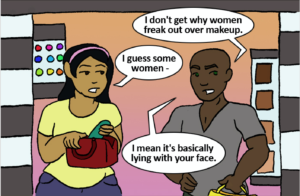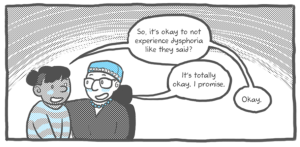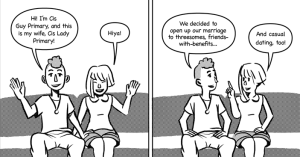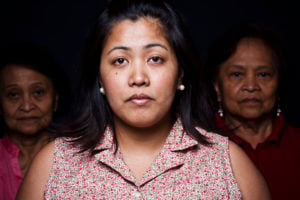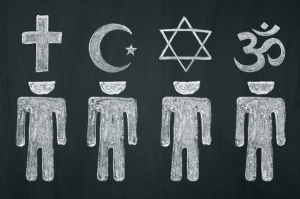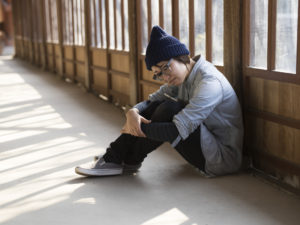
A young adult sits on the floor, arms wrapped around their knees, looking thoughtful.
We see them on our way to work and school. Pass by them when entering or leaving a store. We try to avoid their gaze. We try to ignore the twinge of guilt we feel for having more than they do, for not always sharing what we have.
These are the homeless people we come across everyday. Some might even view them as a nuisance because they make us question our morality, and this makes us uncomfortable.
According to reports, in January of 2014, there were 578,424 homeless people in the US. Between 2013 and 2014, seventeen states saw an increase in their homeless population. And this isn’t just adults either. This includes whole families, children, veterans, and the mentally ill.
Although homeless people and their experiences vary widely, society provides us with a very limited image of what homelessness looks like.
Media seems to prioritize representation based on class. This means that the issues concerning middle and upper class people are given more airtime. This leads to issues relating to homelessness being grossly underrepresented in the news.
Public policy has long ignored issues related to homelessness. Some states have even begun to prohibit sleeping and panhandling in public areas. This is an attempt to erase homelessness from public view. If we can’t see it, then it’s not real, right?
It is difficult to understand why this isn’t a priority considering the US has one of the largest economies in the world, as well as one of the highest rates of consumption.
Homelessness is already highly misunderstood, and the more we try to make it go away, the more it continues to grow. We avoid thinking about it, as if it can’t happen to us. It may not be an issue that hits close to home now, but eventually it could be.
However, it’s not something that’s immediately recognizable just by looking at a person, their clothing, or any belongings they might possess. This is the problem we often come across because the representations of homelessness we’ve been exposed to are so limited.
As someone who has experienced homelessness in my youth and as an adult, this is one of the obstacles that made me seem illegitimate and undeserving of help. My physical appearance didn’t match the image of homelessness we’re familiar with. Experiencing homelessness as an adult looked different for me than the stereotype: I had a phone. I had nice clothes. I had a job.
The reality is that the homeless people we see on the streets are not representative of homelessness as a whole, although they are a significant part of it. Many homeless people just don’t have the guarantee of a secure and safe place to sleep at the end of the day. Sometimes this means they bounce around from place to place wherever shelter is available – and this absolutely counts as homelessness.
Instead of avoiding the problem, we need to understand it and do what we can to alleviate it.
Understanding this issue means unlearning the myths we have learned about what it means to be homeless. It’s best to approach it without bias and judgment and with our eyes wide open – because anyone can be at risk.
Let’s start here.
Myth #1: Homeless People Aren’t Trying
Some people get very upset when confronted with a homeless person because they truly believe homeless people aren’t trying or are apathetic in their situation. They may even tell the person to get a job out of frustration. There’s an assumption that homeless people spend all day doing nothing except for asking others for money.
What we don’t realize is that many homeless people actually do have jobs. These jobs are often jobs that pay under the table. This means that employers may not be paying homeless employees enough to live of off. It also means homeless employees are more likely to experience unfair treatment because they’re not on the payroll.
Not having a job isn’t always a choice either. Many homeless people who have committed nonviolent crimes have a difficult time being hired even when they spend the time applying for jobs and going to interviews. It’s not a lack of effort that prevents them from finding work.
There also seems to be a misconception that giving in to homelessness is taking the easy way out. However, being homeless is by no means easy. It requires a lot of effort and will to survive each day without the basic necessities.
We know how difficult it can be to focus on anything when we’re hungry. For homeless people, every day is a new struggle to find food. This struggle means finding transportation and money to get to that food.
Apart from the struggle to find nourishment, there is also the need to find a safe place to sleep at night where they’re not exposed to the elements.
Homeless people work hard for the basic necessities we take advantage of and don’t think twice about every single day. Not acknowledging this diminishes compassion and makes it easier to judge instead of helping.
Myth #2: Homelessness Is a Choice
Being homeless is not a choice; it is a process, regardless of the choices people make leading up to becoming homeless.
This process begins with the environment we live in, traumatic experiences, and coping mechanisms – all of which are affected by our identity. The lack of privileges we’re afforded based on that identity might prevent us from receiving the support needed to avoid homelessness.
Many homeless women are survivors of domestic abuse. These women lack a support system and may be unable to seek resources.
If they depend on their abuser for financial stability, it can be difficult to find the money for a new home, especially when they are prevented from working by their abuser.
For whole families, a lack of affordable housing and unemployment can mean the separation of family. While more people are willing to take in homeless children, they may be more cautious or just not have enough space to provide shelter for parents.
Children also become homeless for a number of reasons, including neglectful and dysfunctional families, disabilities, and a lack of a support system for those who identify as part of the LGBTQIA+ community. These children leave their families in the hopes of finding a support system and financial stability.
What too often happens to these children is that they find support from places that are even more toxic than the situations they left behind. This means getting involved with gangs, drugs, and even forced sex trafficking.
Many veterans also experience homelessness when returning from service. Veterans who suffer from mental illness become homeless when they’re unable to assimilate into a society that doesn’t understand their emotional and mental struggles.
By continuing to accept that homelessness is a choice, we become complacent in the belief that we can’t help those who choose not to help themselves. And this benefits no one.
Myth #3: Homeless People Are Uneducated
Between 2013 and 2014, there were 32,494 homeless students enrolled in public schools. This is an 8% increase from the previous school year. This is proof that homeless people are not uneducated; it just means they have more obstacles to attain their education.
For many students experiencing homelessness, school can feel like a safe haven. Although being in school by no means wipes away the hardships of homelessness, it does for a short time allow students to focus on something else. What they learn in school and the connections they make could inspire them to keep going and keep fighting to escape their current situation.
Some students who have grown up in poverty decide to attend college because they have been told education is the way out of poverty.
But according to 2015 FAFSA reports, 58,000 of our college students are homeless.
Even for students who do manage to finish school and graduate with a degree, there’s no guarantee that this will get them a career or even a job that will help make ends meet. Add student loans on top of that, and the problem is further complicated. Often, the monthly payments for student loans take a toll on already limited incomes.
We’re impressed by the stories we hear on the news about the rare college-educated homeless person. The unfortunate reality is that these stories are much more common than we know.
This is harmful because it reinforces the misconception that education will provide an escape from homelessness and that homeless people must therefore not be educated. This is just not true.
Myth #4: Homeless People Are Mostly Single White Men or People of Color
The most common image of a homeless person we’ve been exposed to is that of either the single white man or the person of color. But this isn’t an accurate representation of the homeless population.
Looking at the intersections of homelessness and gender, national reports claim women with children make up 60% of our homeless, which is often due to domestic abuse, compared to 41% of men with children.
Intersections of homelessness and race also show that while Black people make up 12% of the population, they make up 42% of our homeless population. Latinxs make up 12% of the population, but 20% of homeless. Native Americans make up 1% of the population, but 4% of homeless. Asians make up 1% of the population, but 2% of homeless.
This is a highly disproportionate representation, which leads to further misconceptions about who is experiencing homelessness. Lack of awareness about the reality of homelessness within these groups translates to less resources and support.
Although it’s clear that homeless people are not mostly single white men, we must still acknowledge that they do make up a significant portion of the homeless population.
Myth #5: Homelessness Is a City Problem
While homelessness does appear to be a city problem, rural areas have been hit hard in recent years by homelessness, often due to economic factors.
The problem with representation here lies in what we consider to be homeless. While in the city, it’s easier to come across homeless people, homeless folks in rural areas may be living with relatives or may experience homelessness for a shorter period of time compared to those in cities.
Another difference lies in representation based on ability to access resources. The homeless in cities have more access to resources and more resources to choose from because the problem is more visible in cities. If homeless people in rural areas don’t access resources, they’re not represented in statistics.
Although homelessness is an issue in rural areas, it’s a larger problem in cities when considering the movement of homeless people from rural areas to cities in search of jobs and resources.
However, it’s dangerous to assume that homelessness doesn’t exist outside the city – because it means less funding for services in rural areas and only increases the homeless population in cities.
Myth #6: Providing Services and Buildings for Homeless People Will End Homelessness
Although increasing services offered to homeless people is helpful, it’s only the first step. This alone won’t end homelessness.
Why?
Because providing services doesn’t guarantee homeless people will have easy access to these services or will even be aware these services exist.
Some claim that since affordable housing is a huge problem concerning homeless people and those at risk of homelessness, building more affordable housing will eradicate the problem. This isn’t the case because it still doesn’t guarantee that they’ll be able to afford this seemingly affordable housing.
Yes, providing housing and shelter is a necessary step. However, what’s really needed is the ability to reach as many homeless people as possible so that they can benefit from these services.
Unfortunately, there are barriers that make reaching out very difficult. Some of these hard-to-reach people may have had negative experiences in the past and choose not to seek help or just don’t have the means to access services based on location or time of day.
Myth #7: My Chances of Being Homeless Are Slim
Since the homeless population varies in so many ways, it’s much more likely than we think to become homeless.
Although homeless people do live in extreme poverty, poverty itself is not always the sole cause of homelessness.
So what are some other factors that can put us at risk?
As previously mentioned, domestic abuse is a risk factor, especially for women with children. Children in foster care are also at a high risk because resources aren’t always guaranteed. Other factors include not having a strong support system, dealing with mental or other health problems, and drug use.
Not having a strong support system, particularly for people who identify as part of the LGBTQIA+ community, are at a huge risk of homelessness. In fact, 40% of youth who experience homelessness are members of the LGBTQIA+ community, a statistic we tend to ignore when talking about homelessness.
With the fluctuation of our economy, anyone can be at risk of becoming homeless.
It’s very likely that most people know and love someone who is homeless without actually knowing they are. And this is precisely why we need to fight against misconceptions that prevent us from wanting to help.
Myth #8: Homeless People Should Only Get Housing If They Prove They Deserve It First
In debates about homelessness, the topic of whether homeless people deserve resources is common.
It seems society is more comfortable providing housing and other resources to people who have jobs, have received treatment, or have done something to prove they’re somehow “deserving” of basic human necessities.
This isn’t helpful at all – because by questioning whether they deserve help, we’re perpetuating stereotypes that homeless people are careless and uneducated. This implies they haven’t already done what they could to get help in the first place.
These people deserve help just as much as anyone else does. We all come across rough patches in our lives, and some last longer than others, but this doesn’t mean we are more deserving of help than those struggling with homelessness.
Without first attending to basic necessities, it’s difficult to focus on other goals like finding work and receiving treatment for drug use or mental illness. We must focus on providing our homeless population with housing, food, and other necessities that will help them become stable enough to continue to improve these conditions.
***
As someone who has experienced the harsh reality of homelessness as a child and as an adult, I know homelessness is not always visible. This is an image and representation problem.
But instead of holding onto images and stereotypes that prevent us from helping, we need to let go of what we thought we knew and help others do the same. This is a problem with many complicated parts – and what we see or are shown is not always the whole story.
Through awareness, support, continued discussions, and wider visibility, it’s possible to change our perceptions and alleviate a problem we have ignored and allowed to grow for far too long.
[do_widget id=’text-101′]
Katherine Garcia is a Contributing Writer for Everyday Feminism. She is a recent college graduate with a BA in Radio, TV, Film and soon to be graduate school student pursuing a Masters in Women and Gender Studies. She is passionate about LGBTQIA+ rights, domestic violence advocacy, Latinx issues, and mental health awareness, as well as 80s hair metal, used book stores, astrology, and chocolate. You can follow her on Twitter @TheLazyVegan1.
Search our 3000+ articles!
Read our articles about:
Our online racial justice training
Used by hundreds of universities, non-profits, and businesses.
Click to learn more








